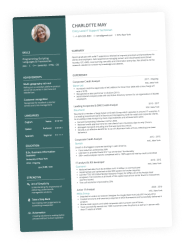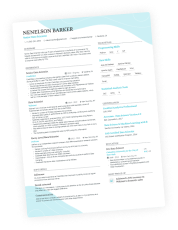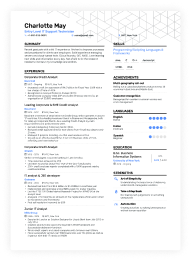Crafting the perfect resume means knowing what to include—and what to leave out. While often overlooked, your driver’s license can be a powerful detail that sets you apart, particularly in jobs that involve travel or transportation.
A valid license demonstrates reliability, flexibility, and readiness to meet logistical demands. The key is knowing when it matters, how to format it, and how to avoid common mistakes. This guide will walk you through every detail so you can present your qualifications with confidence.
Key takeaways
- Include your driver’s license if the job requires travel, transportation, or vehicle use.
- Omit it for desk jobs or fully remote roles where it adds no value.
- Place license details under “Skills,” “Certifications,” or a dedicated “Licenses” section.
- Never list your license number or sensitive personal details.
- Highlight endorsements (e.g., HazMat, Passenger) if relevant to the role.
- Keep the information current and valid—never list expired licenses.
- Without a license, emphasize alternative strengths (e.g., public transit skills, flexibility).
Why your driver’s license can give you a job-hunt advantage
Your driver’s license isn’t just identification—it can be proof of responsibility and independence. Employers often see it as a sign of reliability, especially in travel-related roles.
For example:
- Sales representatives need to meet clients in different locations.
- Delivery drivers must meet strict logistical requirements.
- Field technicians rely on mobility to reach worksites.
Including this information signals to employers that you can meet practical demands. Next, let’s look at how different license types can affect your career opportunities.
PRO TIP
A driver’s license only belongs on your resume if it’s directly relevant to the job. In the U.S. and UK, it’s usually unnecessary unless the role requires driving. While in parts of Europe and the Middle East, it’s more common to include it for practical reasons. As a rule of thumb, add it only when mobility is essential to the position. Otherwise, save space for achievements and skills that strengthen your application.
Is your resume good enough?
Drop your resume here or choose a file. PDF & DOCX only. Max 2MB file size.
Types and categories of driver’s licenses
Not all licenses carry the same weight. Understanding license categories helps you decide what to showcase on your resume.
Types & categories
- Standard Driver’s License: Common and covers personal use.
- Commercial Driver’s Licenses (CDLs): Required for heavy vehicles or specialized roles.
- Class A: Large vehicles with trailers.
Class B: Heavy single vehicles.
Class C: Passenger transport or hazardous materials.
- Endorsements: Added certifications for specific driving tasks (e.g., HazMat, School Bus).
Note: The license categories listed here are specific to the United States. Classifications and requirements vary across countries, so always use the terminology from your own location when including a driver’s license on your resume.
For job seekers, the distinction is crucial. If your role requires specialized driving, endorsements can set you apart. This leads us to the question of when to include this information at all.
When to include (and when to skip) your driver’s license
A driver’s license is valuable—but only when it’s relevant. Knowing when to include it makes your resume more focused.
Include it if:
- The role requires travel, transportation, or driving.
- The job description explicitly mentions a license requirement.
Skip it if:
- The role is remote or fully office-based.
- The license adds no value to your candidacy.
For example, list your license prominently for a field technician job, but leave it out for a software engineering role. Now, let’s talk about the details you should avoid.
What not to include
While a driver’s license can strengthen your application, oversharing can backfire. Keep your information professional and relevant.
- Never share your license number or personal identifiers.
- Avoid listing expired or suspended licenses.
- Exclude irrelevant endorsements or restrictions.
By being selective, you keep your resume clean and focused. With that in mind, the next step is formatting it effectively.
How to format and present driver’s license details
The way you phrase your license information makes a big difference. The goal is to be clear, professional, and easy for recruiters to scan.
Best practices
- State the class of license (e.g., Class B Commercial Driver’s License).
- Add relevant endorsements (e.g., HazMat, Passenger).
- Include the issuing authority (e.g., California DMV).
- Mention a clean driving record or years of operational experience if relevant.
- Avoid listing sensitive details like license numbers or unnecessary restriction details.
Sample format:
- Commercial Driver’s License (Class B) — California
- Endorsements: P (Passenger), H (Hazardous Materials)
- Clean driving record | 8 years of operational experience
This information can sit in a “Licenses and Certifications” section or alongside your professional summary (or resume objective if you’re a newcomer to the industry) if it’s a central qualification.
Think of it as another certification—presented with the same clarity and confidence.
Optimize your resume summary and objective for ATS
Drop your resume here or choose a file.
PDF & DOCX only. Max 2MB file size.
Where to list a driver’s license on a resume
Placement matters just as much as content. The right location ensures your license supports your candidacy without distracting from your core skills.
Here are the most common options:
- Resume header or personal details section: Simple mention, such as “Valid Driver’s License” if it’s a must-have for the role.
- Skills section: Useful when driving is one of several technical or safety-related qualifications.
- Licenses and Certifications section: Best for roles requiring a CDL, endorsements, or other driving qualifications.
- Professional summary: Mention only if the job strongly emphasizes driving ability (e.g., “Experienced delivery driver with a Class B CDL and hazardous materials endorsement”).
- Work Experience section: Ideal if driving was central to your responsibilities (e.g., “Operated company vehicle to deliver goods across four states, maintaining a spotless driving record”).
Rule of thumb
Highlight it where it’s most relevant. A clean driving record or hazardous materials endorsement belongs under licenses and certifications. A general license might fit neatly into the personal details section.
Examples and templates for including a driver’s license
When it comes to showcasing your driver’s license on a resume, examples make the process easier. Using resume templates and sample resume phrases helps you understand where and how to place this information so it supports your overall professional qualifications.
Here are three role-specific examples:
Example 1
Transportation and logistics
- Class A Commercial Driver’s License (CDL) — Texas
- Endorsements: H (Hazardous Materials), T (Doubles/Triples)
- 10+ years of safe driving with a clean record
Example 2
Sales or field service
- Valid Driver’s License — Full Driving Licence
- Clean record | 5+ years of client-facing travel experience
Example 3
General office roles with light travel
- Driver’s License: Valid and unrestricted
- Ability to commute or travel as needed
These examples can be added under a “Skills” section, a “Licenses and Certifications” section, or even your “Work Experience” if the role heavily involves driving. A well-placed driver’s license detail shows employers that you’ve thought carefully about matching your resume to the job description.
Specialized and professional driving licenses
Some jobs require more than a standard driver’s license. In these cases, specialized licenses and endorsements highlight your advanced training and readiness.
Examples include:
- Commercial Driver’s License (CDL): Essential for trucking and logistics.
- Hazardous Materials Endorsement (HME): Shows eligibility to handle dangerous goods.
- Passenger Endorsement: Required for bus, shuttle, or rideshare operators.
- Tanker Endorsement: For transporting liquids.
- School Bus Endorsement: Indicates clearance to transport students.
- Heavy Rigid Licence or Class A Non-Commercial Driver’s License: Industry-specific driving qualifications.
- Basic Fatigue Management Certificate: Demonstrates compliance with professional driving standards.
When listing these, place them in the “Licenses and Certifications” section for maximum visibility. Pair endorsements with work experience (e.g., “Operated commercial passenger vehicles under CPVA accreditation with a spotless safety record”).
Highlighting these details shows that you meet strict compliance requirements and adds weight to your application in transportation, logistics, and safety-sensitive industries.
Frequently asked questions and additional considerations
Job seekers often wonder how far to go when listing their driver’s license.
Below are some common questions and considerations:
Q. Is a driver’s license a skill?
A. While not typically a core skill, a license can be treated as part of your driving and safety skills. This is especially true if you take defensive driving courses, fatigue management and log-book duties, or vehicle repair and maintenance training.
Q. What counts as a clean driving record?
A. A clean record usually means no recent major violations, suspensions, or at-fault accidents. Employers in logistics, delivery, and transportation often list this as a requirement in the job listing.
Q. Should I mention manual vs. automatic license?
A. Only if the job requires it. For example, commercial or specialized roles may prefer a manual license for flexibility.
Q. Can certifications boost my resume?
A. Absolutely. Including a cargo securement certification or a recognized safe driving course can strengthen your profile by proving competence beyond a standard license.
By anticipating these questions, you can refine how you present your driver’s license and related skills section details.
If you don’t have a driver’s license
Not having a license doesn’t mean you’re out of options. You can highlight alternative strengths.
- Emphasize reliable use of public transit or ridesharing.
- Focus on transferable skills such as time management and adaptability.
- Apply for roles that don’t require driving (tech, creative, office jobs).
- Frame employment gaps as opportunities for growth and resourcefulness.
By presenting alternatives, you show resilience and readiness.
Conclusion
A driver’s license can be a valuable asset—especially in roles where mobility matters. Whether you’re applying in logistics, sales, or customer-facing fields, including it demonstrates reliability and adaptability. However, for remote or desk-based jobs, it’s best left off.
To make your resume shine, consider using Enhancv’s free AI Resume Builder. It formats your license and other details seamlessly, saving time while ensuring your resume looks polished and professional. With every detail presented clearly, you’ll be ready to stand out in today’s competitive job market.
Make one that's truly you.



